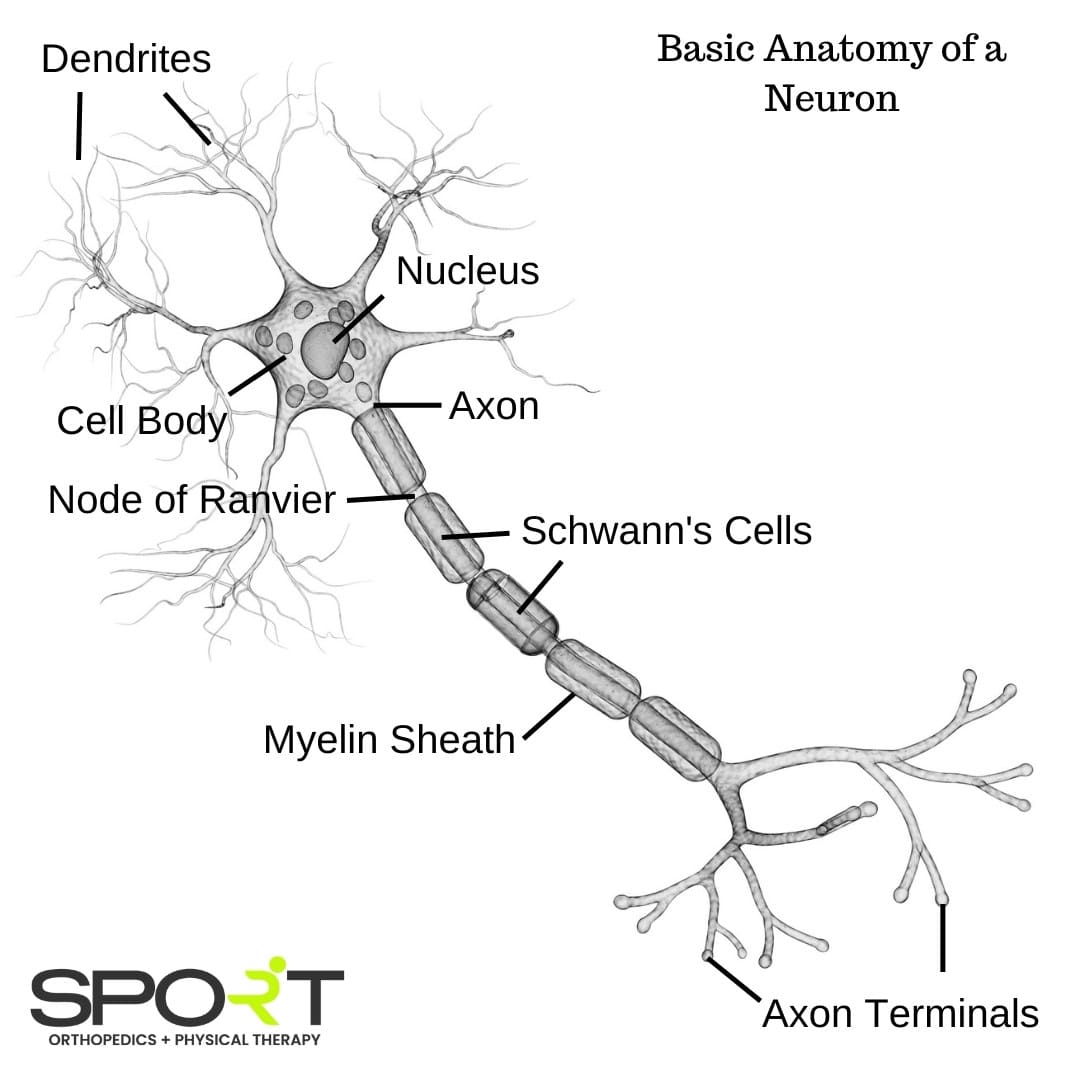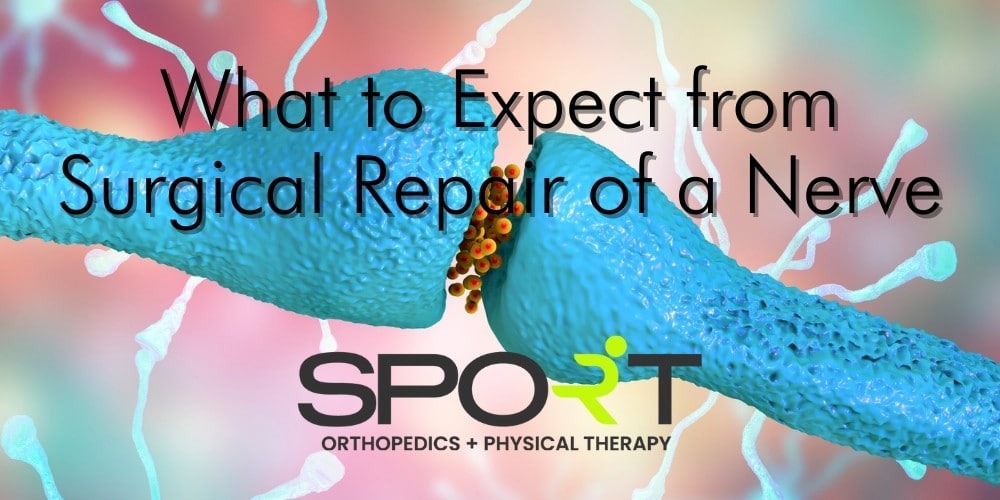If you sustain a nerve injury, this can impact your ability to take part in activities you once enjoyed. Nerve injuries in the hand are particularly debilitating, as many people need full use of their hands for their jobs. Many things can cause a nerve injury, including trauma, infections, and chronic diseases. Sometimes, these injuries require surgical repair of a nerve to correct. Peripheral nerve surgery aims to restore function and sensation in the area.
At SPORT Orthopedics + Physical Therapy, we understand that living with an injured nerve can be painful and frustrating. If you suffer from chronic pain, it may be time to consider a nerve graft. Our highly experienced and qualified orthopaedic surgeons can evaluate and treat your nerve damage with a personalized treatment plan. To schedule an appointment with our talented surgeons, please call 469-200-2832 today.
Anatomy of a Nerve

Before we begin, it’s important to understand the structure of a nerve cell (neuron). The nerves that branch out from your central nervous system (the brain and spinal cord) are called peripheral nerves. They make up the peripheral nervous system. The two types of peripheral nerves are called sensory nerves and motor nerves. A sensory nerve serves to transmit outside information to the central nervous system. A motor nerve serves to deliver information from the central nervous system to the muscles, organs, and glands in the body.
Below, we outline the functions of each part of a neuron.
- Dendrites: The dendrites receive information and input from other neurons.
- Cell body (soma): The soma, or cell body, makes the proteins necessary for proper nerve function.
- Nucleus: The nucleus houses the neuron’s genetic material (chromosomes) that directs the production of proteins.
- Axon: The axon is basically the pathway along which electrical impulses travel to the other end of the neuron.
- Node of Ranvier: The Node of Ranvier quickly conducts electrical nerve impulses along the axon pathway.
- Schwann cells: The Schwann cell is responsible for nerve regeneration, maintenance, function, and development. Basically, they keep the nerve fibers alive.
- Myelin sheath: The myelin sheath surrounds the Schwann cells along the axon. It helps to quickly transmit nerve impulses along the axon pathway.
- Axon terminals: The axon terminal sends nerve impulses to other nerves.
What Is Nerve Repair Surgery?
Nerve surgery begins with an examination of your injured nerve with the use of a powerful microscope. The surgical method used to complete the repair depends on a number of factors, including the location of the nerve and the cause of your pain. It’s important to consult with your doctor about your surgical options. Depending on what your surgeon finds when they examine the nerve, it’s better to be informed of all possible routes ahead of time. The most straightforward option is called end-to-end nerve repair.
What Is a Nerve Graft?
Nerve grafts are among the most popular methods for repairing a damaged nerve. A nerve graft is also called nerve transplant surgery. During nerve graft repair, your surgeon will take a piece of donor nerve tissue and use it to fill the nerve gap between the two ends of a damaged nerve. There are two main types of nerve grafting: a nerve autograft and a nerve allograft.
Nerve autografts are donor nerves taken from within your own body. Generally, a surgeon will use a sensory nerve from a location where sensation is not essential. Nerve allografts are taken from cadavers. This type of donor nerve must be properly sterilized and processed in order to avoid rejection by the patient’s body.
How Does Nerve Grafting Work?
Nerve grafts allow the axons in the neuron to regenerate and close the nerve gap. Autografts from your body (or allografts from a cadaver) contain support cells (or Schwann’s cells). Schwann’s cells aid your nerve fibers with regeneration and repair.
Why Is Nerve Repair Surgery Done?
Generally, medical professionals will attempt more conservative treatment options before suggesting surgery for peripheral nerve injuries. However, if these conservative treatments prove fruitless, surgery may be your only remaining option. If a portion of a neuron is completely severed or damaged beyond the point of self-repair, surgery is the preferred option.
The more severe the peripheral nerve injury, the more likely we are to recommend surgical repair. Two of the most popular options for achieving this are primary nerve repairs and nerve grafting.
What Types of Conditions Can Be Treated with Nerve Graft Surgery?
Many conditions benefit from nerve repair surgery. Some of the conditions most commonly-treated with grafting and nerve transfers include the following.
- Scarring or stretching injuries to the nerves
- Brachial plexus injuries, such as Erb’s palsy and global palsy
- Cancer and tumor growths
- Facial paralysis
- Peroneal nerve entrapment
Who Can Benefit from a Nerve Graft?
Nerve pain can truly hinder your everyday activities. Nerve grafts and nerve transfers are just two of the many options you have for achieving nerve pain relief. Below, we list some of the characteristics that good candidates for injured nerve surgery might have.
- Your nerve injury has caused you to experience consistent pain in a specific area that has lasted for longer than three months. Your pain has not improved with physical therapy or other pain management methods.
- You have pain that began after prior surgery, and that pain has lasted for longer than three months.
- A doctor has previously tested you for the source of your pain and determined that there is no source other than your nerves.
- You have had pain lasting longer than three months after a major traumatic event or after significant weight loss.
- You have diabetes and are experiencing new foot pain related to the condition.
Types of Surgical Nerve Repair

There are many surgical procedures that help with nerve pain. Below, we list some of the most common surgical procedures used to treat persistent nerve pain.
- Carpal tunnel release
- Nerve repair surgery
- Nerve graft surgery
- Open decompression surgery
- Nerve entrapment surgery
- Nerve transfer surgery
- Sensory nerve surgery
- Nerve transplant surgery
- Brachial plexus surgery
Which Nerves Can Be Used for Harvesting a Graft?
Certain nerves are far more suitable for harvesting than others. The sural nerve in the leg and the lateral antebrachial cutaneous nerves in the arm are popularly used for graft material. When choosing which neuron to use for the graft, your surgeon will consider the nerve’s function. This is a major factor, as you don’t want to lose sensation in a critical part of your body.
How to Prepare for Nerve Repair Surgery
Generally, we counsel our patients on how to prepare for their surgery well in advance. Schedule a consultation with your surgeon for specific instructions to follow before your procedure. In general, you will be advised to do the following.
- Stop smoking and taking any vitamins, supplements, or medications that your surgeon asks you to stop taking.
- Arrange for someone else to drive you home after the surgery.
- For major surgery, arrange for someone to help you with the first few days of your recovery.
What to Expect During Surgical Repair of a Nerve
You will likely be under general anesthesia for the entirety of the procedure. This ensures that you feel comfortable and pain-free. After examining the nerve, your surgeon will decide on which repair method to employ. The three most popular repair options are nerve grafting, using conduits, and reconnecting the nerve without stretching it.
What to Expect After Surgical Repair of a Nerve
As we stated before, you will need a ride home after the surgery, regardless of whether it is an inpatient or outpatient procedure. Depending on which nerve was repaired, you may need help for the following few days after the surgery. It’s important that you remain patient during the recovery process. After all, the nerve ends need time to fully heal and regrow.
It can take anywhere from six months to one year for the nerve to reach the muscle. Then, it will take anywhere from one year to one and a half years to recover function in the muscle. During this long recovery period, you must strictly adhere to your physical therapy plan.
Physical therapy helps to safely and gradually restore muscle function. It also prevents further nerve damage by keeping your neurons active with electrical stimulation.
How Successful Are Nerve Grafts?
Success rates for reconstructive surgery of nerves depend heavily on the following factors.
- Type of nerve injury you suffered
- Where the injury occurred
- The severity of the injury
- Blood supply in the affected area
- The skills and experience of your surgeon
Ultimately, the goal of nerve surgery is to achieve improvements, not perfection. Approximately 80-90% of patients see significant improvement after surgical repair of a nerve.
Contact SPORT Orthopedics + Physical Therapy Today
At SPORT Orthopedics + Physical Therapy, our surgeons are highly skilled with decades of experience under their belts. We take great care and pride in our evaluation and treatment of patients. Our top priority is ensuring that you have a safe, pleasant healing experience with our team of orthopedic professionals. To schedule a consultation with one of our surgical experts, please call our office at 469-200-2832 today.



